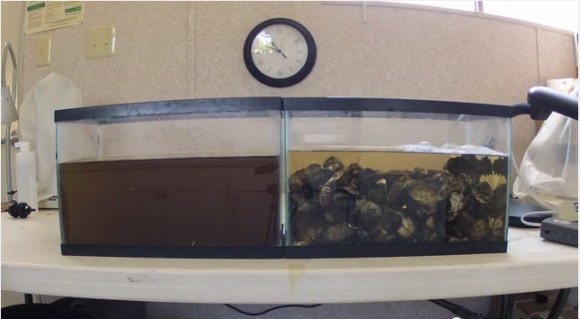
You may be familiar with oysters as the delicious seafood best eaten raw (or as ice cream) and served in months ending in “r,” but did you also know the little guys have impressive filtering skills that can clean even the dirtiest water?
Eating its fill of plankton and other particles floating around, a fully grown oyster can filter more than 50 gallons (189 liters) of seawater in one day. After seeing a few videos demonstrating this cleaning ability, some Japanese netizens started to question just how appetizing this made the once delicious-looking oyster.
In the video posted by a U.S. environmental advocacy group, two tanks of dirty water are placed right next to each other with the only difference being that one is filled with oysters. About two hours pass in the short time-lapse video and the oyster-filled tank looks practically clear by the end.
As you can see it dramatically displayed in the video above, the humble oyster does a pretty amazing job of keeping bodies of water clean (and arguably better than NASA-designed water bottles). And for most of history, natural oyster beds have been keeping water clean all over the world. Check out another video showing a group of oysters at work.
Unfortunately over-harvesting, disease and pollution have taken their toll on oysters all over the world, leaving nature’s water filter at less than one percent of its historical population. And after seeing these videos, Japanese netizens came to realize just how important the oyster is to marine ecosystems. But after pondering the oyster’s role in keeping our oceans clean, viewers began to worry about a different pressing issue: isn’t it a little disgusting to be eating something that has been sucking in all that junk from the ocean?
▼Who cares if oysters have been filter waste from the ocean if you can grill them wrapped in delicious bacon?
A lot of commenters pointed out that while this was great news for cleaning up our oceans, this was bad news for any oyster lover who would be turned off the shellfish after seeing videos of them filtering water so effectively. Some concerned oyster lovers said they would be making sure from now on exactly where their next round of delicious oysters come from and whether or not they were living in polluted waters. And a few commented that eating oysters was no more disgusting then eating liver as it is an organ in an animal’s body that also acts as a filter.
At the end of the day, with the dismal state of some of the world’s water, such as Tokyo Bay’s unfortunate tendency to turn red in the summer months, hopefully our friend the oyster can help us in getting that natural balance back. In the mean time, double-check where your oyster is coming from and say thanks to the hardworking shellfish before you douse him in lemon and sherry vinegar sauce.
Feature Image: YouTube (Florida Oceanographic)
Source: Karapia, National Oceanic Atmospheric Administration